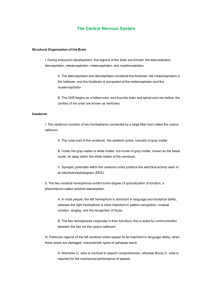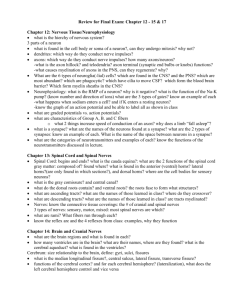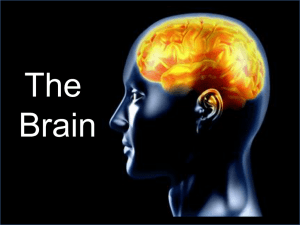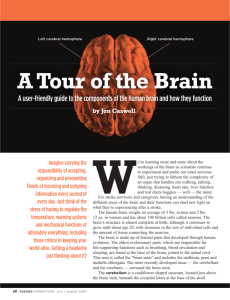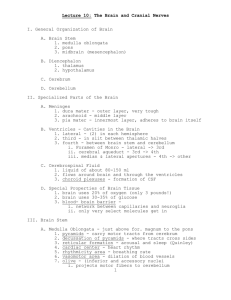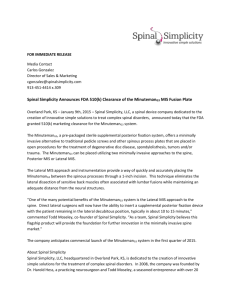The CNS
advertisement
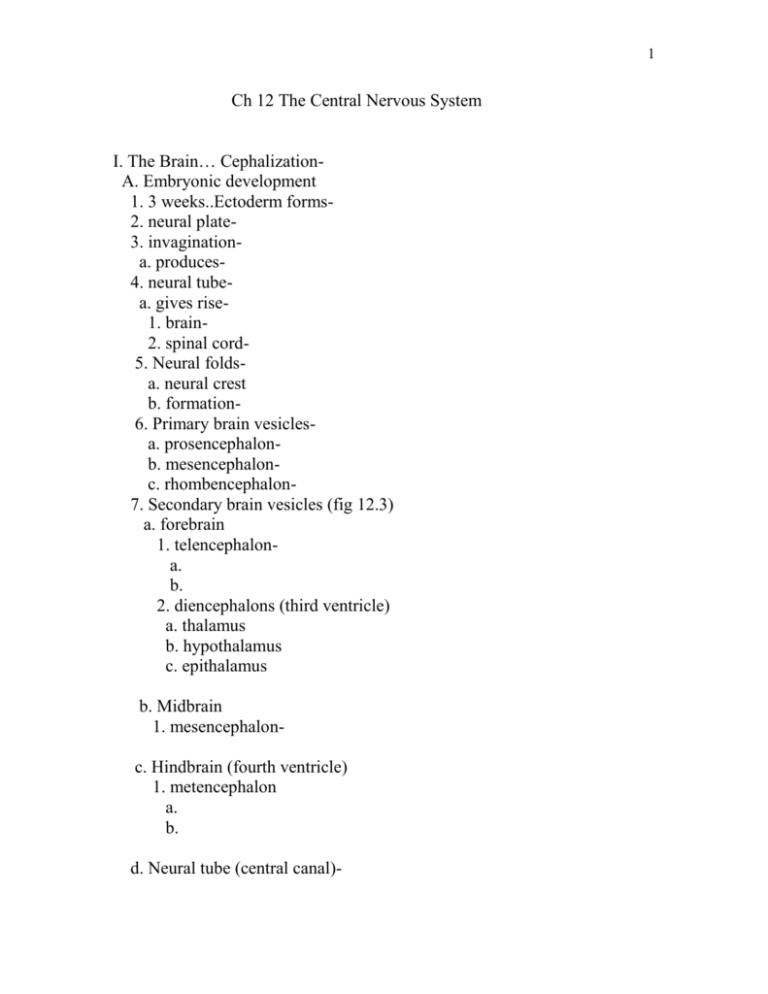
1 Ch 12 The Central Nervous System I. The Brain… CephalizationA. Embryonic development 1. 3 weeks..Ectoderm forms2. neural plate3. invaginationa. produces4. neural tubea. gives rise1. brain2. spinal cord5. Neural foldsa. neural crest b. formation6. Primary brain vesiclesa. prosencephalonb. mesencephalonc. rhombencephalon7. Secondary brain vesicles (fig 12.3) a. forebrain 1. telencephalona. b. 2. diencephalons (third ventricle) a. thalamus b. hypothalamus c. epithalamus b. Midbrain 1. mesencephalonc. Hindbrain (fourth ventricle) 1. metencephalon a. b. d. Neural tube (central canal)- 2 8. Growth shapeA. two flexures (fig 12.3b) 1. midbrain flexure2. cervical flexureB. Forced C. convolutions9. Regions of the Brain - cerebral hemispheres - diencephalon - brain stem 1. midbrain 2. pons 3. medulla - cerebellum 10. Ventricles A. hollowB. linedC. Lateral ventricles (fig 12.5a)1. location2. separateda. septum pellucidum 3. communicateD. Third ventricle1. interventricular foramena. 2. continuousa. cerebral aquaductE. Fourth Ventricle1. openingsa. lateral aperatusb. median aperatusc. function 1. sub arachnoid space- 3 B. Cerebral Hemispheres 1. Form2. mass3. markings a. gyrib. sulcic. fissures1. longitudinal fissure2. transverse fissure4. Sulcusa. Central sulcusb. post/pre central S.c. parieto-occipital S.d. lateral S.1. insulaa. covered by5. Regions ( 3 hemispheres) a. cortexb. white matterc. basal nucleiI. Cortex (conscious mind) A. Generalizations 1. 3 functional areas (domains) a. motorb. sensoryc. association2. neurons3. contralateral4. specialization5. intergration1. Motor areas1. Primary somatic motor cortex (area 4; fig 12.8) a. locationb. contains- 4 2. function3. pyramidal tracts (corticospinal tracts)a. tractsb. projectc. somatotropy (fig 12.9) 1. motor homunculisa. spatial and upside downC. Premotor Cortex (area 6) 1. location2. controlsa. repetitiveb. pyramidal tractsc. planned movementex: Moving your arm through a maze to grasp something D. Broca’s Area (area 44-45) 1. locationa. present2. controlsa. pre- speechE. Frontal eye field (area 8) 1. location2. controls2. Sensory AreasA. locationB. Primary Somatosensory Cortex1. location2. neuronsa. spatial discrimination1. proprioceptorsb. Sensetivity1. 2. 3. homunculus- 5 B. Somatosensory association cortex1. location2. control3. primary somatosensory cortexEx: When you reach into your pocket to feel for a dime. C. Primary Visual Cortex1. locationa. calcarine sulcus2. retinaa. images3. visual association aresa. associationEx: Recognition of a face…especially ugly ones!!! D. Primary Auditory Cortex1. location2. hearing receptorsa. sound3. auditory association areasa. perceptionb. memoryc. Wernicle’s areaE. Olfactory (smell) Cortex1. location2. uncus3. Afferent fibers4. olfactory tracts5. rhinencephalona. limbic systemb. olfactory bulbs and tractsF. Gustatory CortexG. Vestibular Cortex1. location- 6 I. Association area1. primary cortexa. communication2. multiple… 3. independent4. areas not associated with sensory cortices… a. prefrontal cortex1. complex2. involves3. associated with… a limbic system4. lesionsb. Language Areas1. Wernicks areaa. 2. Broca’s area3. lateral prefrontal cortexc. General (common) interpretation areaa. parts of… b. one hemispherec. receives1. Ex: Allows you to perceive the overall picture..in terms of danger!! d. Visceral Association area1. location2. sensationsJ. Lateralization of Corticle function 1. unique2. Cerebral dominancea. languageb. visual-spatial3. Equal or reversed- 7 III. Cerebral White MatterA. locationB.communicationC. composition1. Commisuresa. functionb. corpus collosum1. anterior/posterior2. Association fibersa. short association fibersb. long association fibers3. projection fibersa. cerebral hemispheresb. cortexc. functionIV. Basal NucleiA. caudate B. putamen C. globus pallidus D. lentiform nucleusE. corpus striatumF. AmygdalaFunction: - a role in regulating- controlling movement and intensity- inhibitssummary: The ability to perform or to coordinate several activities at once. Dysfunction..has always been associated with ______________________. 8 V. Diencephalon- Thalamus - Hypothalamus - Epithalamus A. Thalamus1. location2. interthalamic adhesion3. Nucleia. b. 4. Functions (gateway to the cortex) a. all afferent impulses1. crude- recognition of sensation in terms of pleasant/ unpleasent b. c. coordinatingd. intergrationsummary: The thalamus mediates sensation, motor activity, cortical arousal, learning and memory. B. Hypothalamus- hypo below 1. locationa. infundibulumb. pituitary gland2. nuclei3. functionsa. ANS- regulatory control 1. blood pressure 2. heart beat 3. digestive motility 4. respiration b. limbic system- center of…. 1. emotions- pleasure, fear, rage, c. body tempd. food intake- 9 e. regulation of water intake 1. osmoreceptorsa. ADH (anti diuretic hormone)f. Sleep/wake cycle1. suprachiasmatic nucleus- (biological clock) g. Endocrine functions 1. release hormones2. supraoptic nuclei3. paraventricular nucleiC. Epithalamus- most dorsal portion of the diencephalon 1. pineal glanda. secretesfn- induces sleep…sleep/wake cycle 2. choroids plexusa. producesVI. Structures of the Brain Stem (midbrain, pons, medulla) - continuous with the spinal cord - grey matter surrounded by white matter fibers..mylenated fibers - ANS..brain stem functions are involuntary A. Midbrain- (Mesencephalon) located between the diencephalons and the pons 1. cerebral pedunclesa. point of connection2. cerebral aqueduct3. periaqueductal grey matter (in assoc with amygdala) a. b. 4. nuclei- control of two cranial nerves a. occulomotor nuclei b. trochlear nuclei 5. tectum6. superior colliculia. relays sensory input from ears to… b. startle reflex- 10 7. substantia nigra.. a pigmented nuclei a. produces dopamine from neurons arising from here b. mood control c. lesion siteB. Pons: lies between midbrain and medulla and forms the wall of the 4th Ventricle. 1. Conduction tracts: moves in 2 directions a. Deep projectionsb. Superficial tracts1. relays info between___________ and _______________. 2. connects3. cranial nervesa. trigeminal b. abducens c. facial 4. pneumataxic centera. medulla C. Medulla oblongata1. continuous2. ponds and medulla3. pyramids- contains descending corticospinal tracts from_________ ___________. a. decussation of pyramids 1. Crossover point..where __________ and ____________ corticospinal tracts cross 2. Results opposite sides of the brain, operate… a. 4. Cranial nerves associated with… a. hypoglossal b. glossopharyngeal c. vagus 5. Vestibular, cochlear nuclei6. ANS functions a. cardiovascular center1. cardiac center2. vasomotor center- 11 b. respiratory centerc. Various other centers - vomiting - hiccup - swallowing - coughing - sneezing D. The Cerebellum- lies at the base of the brain behind the brain stem and makes up 11% of the Brains mass 1. proprioceptors2. skeletal muscle3. anatomy a. bilateral symmetryb. vermisc. surface convelusionsd. cells 1. purkinje cells2. granule cells3. basket cellse. cerebellar penduncles1. connect2. form3. locations a. Superior Cerebellar peduncles1. function…connectsb. Middle Cerebellar Peduncles1. functionc. Inferior Cerebellar Peduncles1. function…conveys2. Equillibrium and balance E. Functional Brain Systems 12 1. The Limbic Systema. parts of… 1. septal nuclei 2. cingulated gyrus 3. parahippocampal gyrus 4. dentate gyrus 5. hippocampus b. The Fornixc. Emotions1. Cingulate gyrusa. recognizesb. assesses2. Amygdalad. psychosomatic illness1. visceral tractse. cortex association 2. The Reticular Formationa. medulla b. pons c. midbrain d. columns1. raphe nuclei- forms the midline 2. medial (lg cell) group 3. lateral (sm cell) group all are tied to…. e. axonal connectionsfunction: f. Reticular Activating System (RAS) 1. continuousa. b. 13 2. filtera. weakb. strongEx: Your not really aware of your watch and ring until it falls off. c. prevention or… 1. drug effectsa. LSDb. Alcoholc. barbiturates/amphetamines2. inhibited by sleep centers 3. motor arm a. cnsb. ansII. Higher Mental FunctionsA. Brain Waves (EEG)1. detectiona. nature of brain wavesb. waves are… 2. types (fig 12.20b) Hz a. Alpha waves1. Idleb. Beta1. alertc. Theta1. associated withd. Delta1. associated with2. awake adult- 14 3. changes a. b. c. 1. 2. 3. 4. B. Consciousness 1. perceptionsa. b. c. 2. clinical definitions a. alertnessb. drowsinessc. stupord. coma3. physiology a. activity b. neuronalc. all measuredC. Unconscious 1. Syncopea. 1. 2. 2. Comaa. oxygenb. cause1. hypoglycemia2. tumors3. trauma4. drug overdose c. irreversible coma1. measured by- 15 D. Sleep and Sleep-wake cycle 1. sleep 2. types ofa. Non-Rapid Eye Movement (NREM)1. Stage 1 a. b. c.response to stimuli2. stage 2 a. b. c. response to stimuli 3. stage 3 a. wavesb. vital signsc. d. dreams4. stage 4 a. wavesb. vitalsc. arousald. timeb. Rapid Eye Movement (REM) 1. inhibition2. time3. nightmares4. REM periodsEx: start out around 5-10 min..final one is 20-50 min long. 3. Cause of sleep a. adenosine4. Importance a. NREMb. REM1. knowna. agitationb. emotional 16 c. motor2. acetylcholine3. norepinephrinefunction- time to renew chemical balance in limbic system 5. Narcolepsya. REM6. Insomniaa. REMb. emotionalc. drug7. Sleep Apnea a. occuranceb. CO2c. factors 1. alcohol 2. obeisity 3. Hi B.P. E. MemoryA. stages of memory 1. short-term (stm) a. limitsb. preliminary2. long-term (LTM) a. capacityb. limits1. bits of info2. retrievalB. Factors affecting transfer from short to long term memory 1. emotional state a. optimal transferb. neurotransmitter2. rehearsal3. auto memory4. consolidation- 17 C. Catagories of Memory a. factual (declarative) memory 1. information2. consciousb. Skill (procedural) memory 1. skills2. sub-consciousD. Brain structures associated with memory a. visual memoriesb. musicc. memory loss 1. hippocampus/amygdalea. destruction of oneb. both2. anterograde amnesia3. retrograde amnesiad. prefrontal cortexe. hippocampusf. amygdaleg. hypocampus (fig 12.22) E. Mechanisms of Memory a. events1. mRNA2. dendrite spines3. increase4. presynaptic terminal5. neurotransmitters6. new neuronsb. Long Term Potentiation (LPT)1. NMDA receptorsa. release of amino acidsb. activation1. voltage2. chemical ligands3. result- 18 III. Protection of the Brain A. Meninges (membranes) coverings 3 of them 1. functionB. 3 connective tissue membranes 1. Dura Mater (tough mother)a. composition1. periosteal layer2. meningeal layera. becomesb. forms the dural sinus where the two membranes are not fused or joined function: to collect _________ blood from and return it to _________________. 3. dural septaFn- limits… a. flax cerebib. flax cerebellic. tentorium cerebelli 2. Arachnoida. subdural spaceb. sub arachnoid spaceFn- to secure the arachnoid matter to the pia 3. Pia Mater (gentle mother)a. composedb. vascularizedmeningitis-(encephalitis) inflammation of the meninges…two types, 1. 2. C. Cerebral Spinal Fluid (CSF) a. Fillsb. Function 1. suspends2. protection3. nourishment4. chemical5. controls a. b. 19 c. Composition1. less2. contains…more ( Na, Cl, H) and less ( Ca, K) d. Amount- volume… 1. replaced2. choroids plexus a. b. e. Circulationf. Returns to blood in.. 1. dural sinus2. accomplished byHydrocephalus- (water on the brain)D. Blood Brain Barrier- a protective mechanism for the brain: 1. Membrane systema. continuous epithelium b. thick basal laminac. Astrocytesd. tight junctions2. Permiablea. glucose b. essential amino acids c. some electrolytes 3. Impermiable a. metabolic waste b. proteins c. toxinsd. drugse. K+ ions are pumped out 4. Exceptions- breakdown of the BBB a. ventricles1. vomiting centerb. hypothalamusc. new borns- 20 E dysfunctions - concussions- contusions- hemorrhage- edema- CVA’s - ischemia- TIA’s- Degenerative Disease ADParkinsonHuntington’sIV. The Spinal Cord A. Embryonic developmentB. Gross anatomy 1. enclosed2. extends3. dimensions4. surroundeda. spinal dural sheathb. epidural space5. extensiona. areab. lumbar puncture6. conus medullaris7. cauda equine8. denticulate ligaments9. spinal nerves10. enlargementsa. cervicle b. lumbar 11. filum terminaleC. Cross Sectional Anatomy (fig 12.30) A. Gray matter1. posterior (dorsal) horn2. anterior (ventral) horn3. lateral horns4. neurons5. ventral roots- 21 6. dorsal rootsa. dorsal root ganglia7. subdivisionsa. somatic sensory 1. somatic motor b. visceral sensory 1. visceral motor B. White Mattera. Fibers1. ascending2. descending3. transverseb. Columns1. posterior funuculi2. anterior funuculi3. lateral funuculiNote: each has ascending and descending tracts Ex: Ascending posterior spinocerebellar tract Descending “ “ “ C. Tracts(generalizations) 1. decussate2. consist3. somatotropy Ex: sensory neurons enter spinal cord at area of sense D. Neuronal Composition (ascending)A. three successive neurons 1. First order neurons2. Second order neurons3. Third order neuronsE. Main Ascending Pathways1. Non-Specific Ascending pathwaya. lateral/anterior spinothalamic tracts b. transmits- 22 2. Specific Ascending Pathway a. b. transmitsc. two tracts 1. fasciculus cuneatus 2. fasciculus gracilis 3. Spinocerebellar tracts1. 2. 3. function: C. Descending Pathways (refer to table 12.4)1. direct pathways2. indirect pathways3 neuronsa. b. 4. Direct pathsa. regulates5. Indirect Pathsa. Includesb. extrapyramidal system c. complexd. regulates… 1. axial muscles2. muscles3. head, neck and eyeD. Other tracts 1. Rubrospinal tracts2. Reticulospinal tracts3. Superior colliculi (tectospinal tracts)E. Spinal Cord trauma and injury A. Trauma 1. paralysis2. paresthesias3. flaccid paralysis4. spastic paralysis- 23 B. Severed Spinal Cord (transactional cut)1. Thoracic Ti-Li 2. Cervical 3. Hemiplegia4. poliomyelitis (polio- gray matter; myelitis- infection) a. destruction- of.. 1. death2. post polio syndrom a. extreme lethargy b. c. d. cause5. Amyotropic Lateral Sclerosis (ALS) a. Lou Gehrigs disease1. Progressive deteriation of neurons in… a. b. b. death1. dysfunction2. genetica. enzyme (super oxide dismutase ) SODb. Riluzole-
